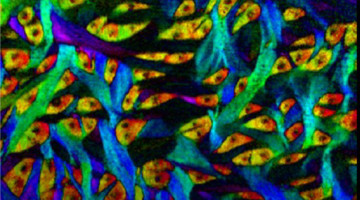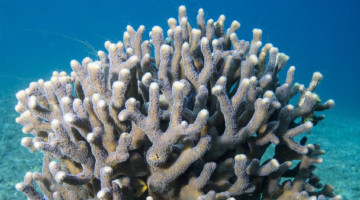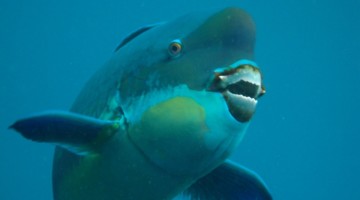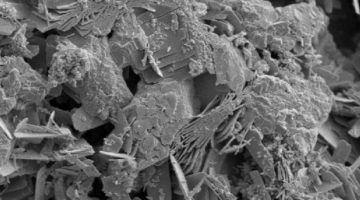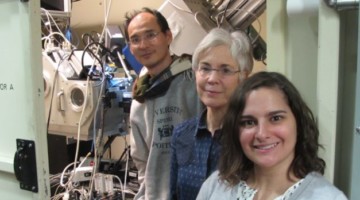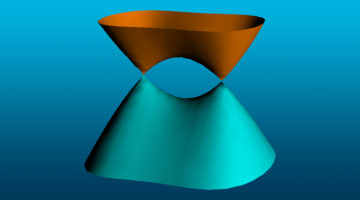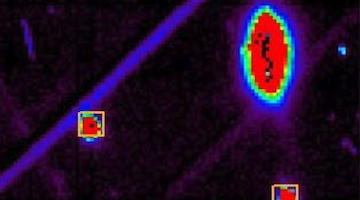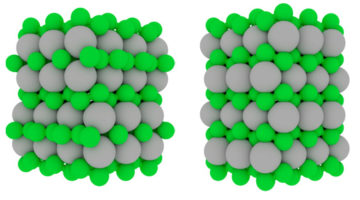A ferromagnetic thin film on a piezoelectric substrate offers a way to control magnetization in ultralow-power devices by relying on coupling between the piezoelectric and ferromagnetic components. At the ALS, researchers were able to image the electrically induced magnetic behavior and correlate it with the piezo-strain driving it. Read more »
ALS Work Using X-Ray Microdiffraction
The Microstructure of a Parrotfish Tooth Contributes to Its Toughness
Parrotfish chew on coral, producing hundreds of pounds of sand each year. Mapping the microstructure of parrotfish teeth, scientists found bundles of crystals interwoven like chain mail. The results provide a blueprint for creating ultra-durable materials for mechanical components that undergo repetitive contact, movement, and abrasion. Read more »
Coral Exoskeleton Growth Begins Inside Living Tissue
Researchers have discovered some good news regarding corals: the mechanism by which their exoskeletons grow may help them resist the effects of ocean acidification. The discovery, made with PEEM studies, has ramifications not only for the health of coral reefs, but for applications such as 3D printing as well. Read more »![]()
![]()
X-Rays Reveal the Biting Truth About Parrotfish Teeth
A parrotfish’s hardy teeth allow it to chomp on coral all day long, ultimately grinding it up through digestion into fine sand. Researchers wanting to see how the fine crystal structure of parrotfish teeth contribute to their incredible strength were able to visualize the orientation of individual crystals, which showed their intricately woven structure. Read more »
The Ancient Roman Secret to Concrete Resilience in Seawater
Researchers used x-ray microdiffraction to trace the complex sequences of crystal growth in concrete from ancient Roman pier and breakwater sites. The results indicate that minerals continue to form over millennia as seawater percolates through, reinforcing the cementing matrix in a kind of regenerative process. Read more »
New Studies of Ancient Concrete Could Teach Us to Do as the Romans Did
A new look inside 2,000-year-old concrete—made from volcanic ash, lime (the product of baked limestone), and seawater—has provided new clues to the evolving chemistry and mineral cements that allow ancient harbor structures to withstand the test of time. Read more »
New Evidence for a Water-Rich History on Mars
Mars may have been a wetter place than previously thought, according to experiments on lab-synthesized mineral samples serving as proxies for Martian meteorites. Shock experiments followed by x-ray diffraction studies showed how changes in the minerals could indicate a more water-rich history for the Red Planet. Read more »![]()
![]()
Strain Turns Tin into a 3D Topological Dirac Semimetal
A small amount of compressive strain turns a nonmetallic form of tin into a 3D topological Dirac semimetal—a kind of “supermetal” with very high electron mobility. With its rich topological phase diagram, the material shows promise for both novel physics and eventual device applications. Read more »![]()
![]()
New Insights into Nanoscale Deformation
A group of scientists used Laue x-ray microdiffraction at the ALS to probe plastic deformation mechanisms at the nanoscale. Their findings may overturn conventional theory and reshape our understanding of the mechanical behavior of a host of nanocrystalline metals. Read more »
Testing the Limits of Superhard Rhenium/Tungsten Diboride
Superhard materials such as metal borides are in demand as structural and engineering compounds and for next-generation cutting tools. Researchers have now synthesized a “solid solution” of two different metal borides, demonstrating the accuracy of theoretical predictions and opening the door to more targeted tuning of desirable characteristics. Read more »

